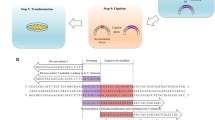Abstract
In the previous chapter we described linker scanning mutagenesis by oligonucleotide ligation. In this chapter we describe a more recent and versatile procedure that makes use of amplification by the polymerase chain reaction (PCR). For a description of the traditional method of generating linker scanning mutants by combination of deletion fragments, see ref. 1.
Access this chapter
Tax calculation will be finalised at checkout
Purchases are for personal use only
Similar content being viewed by others
References
McKnight, S. L and Kingsbury, R. (1982) Transcriptional control signals of a eukaryotic protein-coding gene Science 217, 316–324.
Higuchi, R., Krummel, B., and Saiki, R. K. (1988) A general method of in vitro preparation and specific mutagenesis of DNA fragments: study of pro-tein and DNA interactions. Nucleic Acids Res. 16, 7351–7367.
Ho, S. N., Hunt, H. D., Horton, R. M., Pullen, J. K., and Pease, L. R. (1989) Site-directed mutagenesis by overlap extension using the polymerase chain reaction. Gene 11, 51–59
Sarkar, G. and Sommer, S. S. (1990)The “megaprimer” method of site-directed mutagenesis. Biotechniques 8, 404–407.
Nelson, R. M. and Long, G. L. (1989)A general method of site-directed mutagenesis using a modification of the Thermus aquaticus polymerase chain reaction. Anal. Biochem 180, 147–151.
Perrin, S. and Gilliland, G. (1990) Site-specific mutagenesis using asymmetric polymerase chain reaction and a single mutant primer. Nucleic Acids Res. 18, 7433–7438.
Horton, R M., Cai, Z, Ho, S. N., and Pease, L. R. (1990) Gene splicing by overlap extension: tailor-made genes using the polymerase chain reaction. Biotechniques 8, 528–535
Horton, R. M., Hunt, H. D., Ho, S. N., Pullen, J. K., and Pease, L. R (1989) Engineering hybrid genes without the use of restriction enzymes-gene splic-ing by overlap extension. Gene 11, 61–68.
Vallette, F., Mege, E., Reiss, A., and Adesnik, M. (1989) Construction of mutant and chimeric genes using the polymerase chain reaction Nucleic Acids Res.17, 723–733.
Hemsley, A., Arnheim, N., Toney, M. D., Cortopassi, G, and Galas, D J. (1989) A simple method for site-directed mutagenesis using the polymerase chain reaction. Nucleic Acid Res. 16, 6545–6551.
Jones, D. H. and Howard, B. H. (1990) A rapid method for site-specific mutagenesis and directional subcloning by using the polymerase chain reac-tion to generate recombinant circles. Biotechniques 8, 178–183.
Jayaraman, K., Fingar, S. A., Shah, J., and Fyles, J. (1991) Polymerase chain reaction-mediated gene synthesis: synthesis of a gene coding for isozyme c of horseradish peroxidase. Proc. Natl. Acad. Sci USA 88, 4084–4088.
Sambrook, J., Fritsch E. F., and Maniatis T. (1989) In vitro amplification of DNA by the polymerase chain reaction, in Molecular Cloning: A Laboratory Manual, 2nd ed., Chapter 14, Cold Spring Harbor Laboratory, Cold Spring Harbor, NY, pp. 1431–1435
Saiki, R K. (1989) The design and optimization of the PCR, in PCR Technology: Principles and Applications for DNA Amplification (Erlich, H. A., ed.), Stockton, New York, pp. 7–16.
Gelfand, D. H. (1989) Taq DNA polymerase, in PCR Technology: Principles and Applications for DNA Amplification (Erlich, H. A., ed.), Stockton, New York, pp. 7–122
Dawes, W. J., Miller J F., and Ragsdale, C W. (1988) High efficiency trans-formation of E. coli by high voltage electroporation Nucleic Acids Res 16, 6127–6145.
Dunning, A. M., Talmud, P., and Humphries, S E. (1988) Errors in the poly-merase chain reaction Nucleic Acids Res. 16, 10393
Clark, J. M. (1988) Novel non-templated nucleotide addition reactions catalyzed by prokaryotic and eukaryotic DNA polymerases. Nucleic Acids Res. 16, 9677–9686.
Kuipers, O P., Boot, H. J., and de Vos, W. M. (1991) Improved site-directed mutagenesis method using PCR. Nucleic Acids Res. 19, 4558
Author information
Authors and Affiliations
Editor information
Editors and Affiliations
Rights and permissions
Copyright information
© 1994 Humana Press Inc, Totowa, NJ
About this protocol
Cite this protocol
Harlow, P.P., Hobson, G.M., Benfield, P.A. (1994). Construction of Linker-Scanning Mutations Using the Polymerase Chain Reaction. In: Harwood, A.J. (eds) Protocols for Gene Analysis. Methods in Molecular Biology, vol 31. Humana Press. https://doi.org/10.1385/0-89603-258-2:87
Download citation
DOI: https://doi.org/10.1385/0-89603-258-2:87
Publisher Name: Humana Press
Print ISBN: 978-0-89603-258-3
Online ISBN: 978-1-59259-518-1
eBook Packages: Springer Protocols




